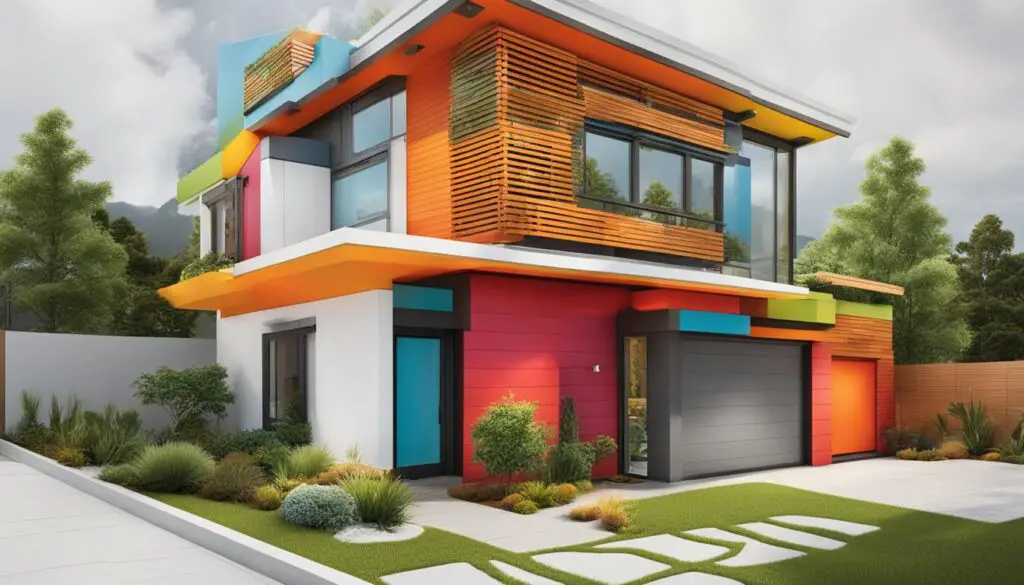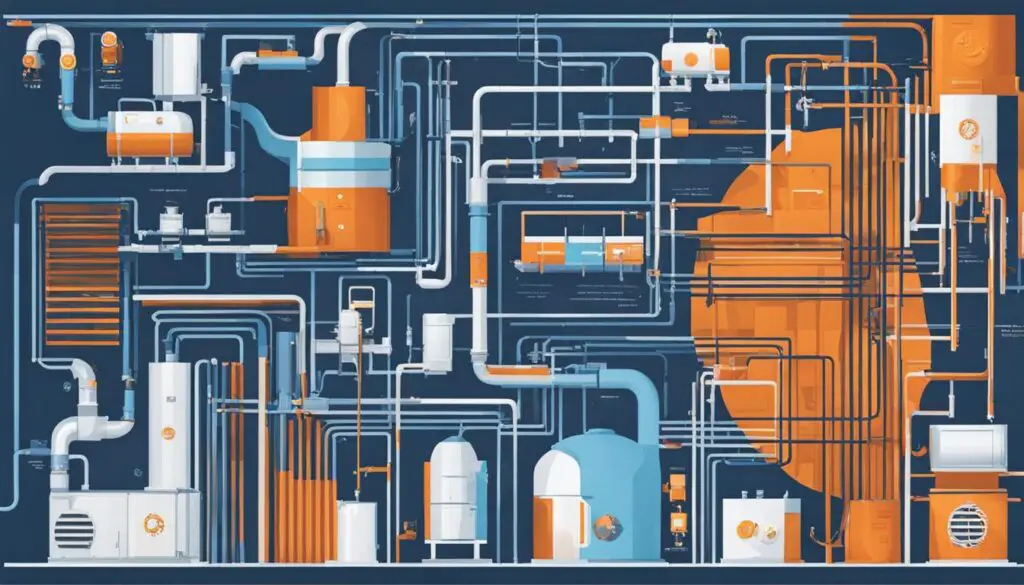Enhancing the air quality in your home is essential for creating a healthier living environment. But you don’t have to spend a fortune to achieve fresher, cleaner air. There are plenty of thrifty ways to improve your home’s air quality without breaking the bank. By implementing budget-friendly solutions, you can enjoy the benefits of improved air quality while staying within your means.
Table of Contents
Key Takeaways:
- Enhancing your home’s air quality doesn’t have to be expensive.
- There are budget-friendly solutions available to improve air quality.
- Creating a healthier living environment is achievable on a budget.
- Implementing thrifty ways can help you enjoy fresher, cleaner air in your home.
- Improving air quality is a vital step towards a healthier lifestyle.
Assess Your Heating System
Before making any changes to your heating system, it’s important to assess its efficiency and potential impact on your energy bills. In today’s world where energy efficiency and lower emissions are crucial, heat pumps have emerged as a popular choice. These systems offer an energy-efficient operation, reducing both your carbon footprint and heating costs. However, it’s essential to consider a few factors before switching to a heat pump.
- Heating Demand: When installing a heat pump, it’s vital to evaluate your home’s heating demand. Heat pumps typically operate at lower temperatures and take longer to warm up a room compared to traditional heating systems. As a result, your heating demand may increase by up to 20% when using a heat pump. This consideration helps ensure that the heat pump is capable of meeting your home’s heating requirements efficiently.
- Insulation Levels: The effectiveness of a heat pump depends on the insulation levels in your home. Proper insulation helps retain the warmth generated by the heat pump and prevents heat loss. Evaluating the insulation levels and addressing any areas that need improvement will optimize the performance of your heat pump and enhance energy efficiency.
- Type of Radiators: Different heat pump systems require specific types of radiators. It’s important to consider the compatibility between your existing radiators and the heat pump system you plan to install. You may need to replace or modify your radiators to ensure optimal heat distribution and efficiency.
- Hot Water Supply: Heat pumps may not provide hot water on demand like traditional heating systems. It’s crucial to evaluate your hot water supply and determine if alternative solutions, such as a separate water heater, are necessary to meet your household’s hot water requirements.
Assessing these factors ensures that your heat pump installation is tailored to your home’s specific needs, maximizing energy efficiency, and achieving lower emissions.
Determining Energy Efficiency
To determine whether a heat pump is a worthwhile investment for your home, it’s essential to evaluate its energy efficiency. Your home’s estimated annual heating demand, measured in kilowatt hours per square meter per year, can be found on your energy performance certificate (EPC). Higher energy-efficient homes with proper insulation and double glazing tend to benefit more from heat pump installations. However, it’s crucial to note that the heating requirement stated on your EPC may not accurately reflect your heating needs with a heat pump. It’s recommended to consider factors such as heat loss, thermal mass, and insulation levels when assessing the energy demand of your home.

Balancing Comfort and Consumption
When using a heat pump, finding a balance between comfort and energy consumption is crucial. Heat pumps operate at a lower temperature, which means it may take longer for a room to warm up compared to traditional heating systems. To achieve the desired comfort level, consider the following:
Adjust the Heat Pump Temperature
Experiment with different heat pump temperature settings to find the optimal balance between comfort and energy consumption. Lowering the temperature slightly can help save energy while still providing a comfortable environment. However, be mindful not to set it too low, as it may affect the overall warmth of the room.
Optimize Your Heating Schedule
Creating a heating schedule that aligns with your daily routine can help minimize energy consumption. Program the heat pump to lower the temperature when you’re away from home or asleep, and raise it before you return or wake up. This way, you can enjoy comfort when you need it most without wasting energy when you don’t.
Consider Constant Setback Temperature
Maintaining a constant setback temperature throughout the day can help strike a balance between comfort and energy efficiency. Set the thermostat to a slightly lower temperature during the day when occupants are typically active, and raise it to a comfortable level during the evening when everyone is at home. This approach ensures energy savings without sacrificing comfort.
In my experience, running the heat on low during the day can help compensate for the heat pump’s lag and provide consistent warmth in the house. This strategy has been effective in finding the right balance between comfort and energy consumption.
Monitor and Adjust
Regularly monitoring and adjusting your heating patterns can help optimize energy consumption while maintaining a comfortable living environment. Keep track of your energy consumption and adjust your heating schedule accordingly. Experiment with different settings to find what works best for your specific needs.

Remember, finding the right balance between comfort and energy consumption is a personal journey. It may take some trial and error to determine the optimal settings for your home. By making conscious decisions and fine-tuning your heating habits, you can enjoy the comfort you desire while minimizing your energy consumption.
Cost Comparison and Future Considerations
When deciding between a gas boiler and a heat pump, running costs play a crucial role in the decision-making process. In some regions, gas prices are generally lower compared to electricity prices, making gas boilers more cost-effective in terms of daily operations. However, it’s important to note that heat pumps can be up to three times more efficient than gas boilers, resulting in significant energy savings over time.
Despite their higher efficiency, heat pumps may not currently be cheaper to run than gas boilers due to the price gap between gas and electricity. However, it’s essential to consider the broader picture and the ongoing transition to decarbonize our energy sources. As electricity prices continue to evolve, there is a possibility of future increases, making heat pumps a potentially cost-neutral or even cost-saving choice in the long run.
When evaluating the cost comparison between gas boilers and heat pumps, it’s crucial to carefully analyze the pricing dynamics in your specific region. The availability and pricing of gas and electricity can vary, depending on factors such as local market conditions and government policies. Additionally, keep in mind that energy prices are subject to change, so it’s essential to consider potential future shifts that may favor the cost neutrality of heat pumps.
By considering long-term implications, you can make an informed decision about the most cost-effective heating solution for your home. While gas boilers may have a current advantage in terms of running costs, the potential benefits of heat pumps in terms of energy savings and reduced greenhouse gas emissions make them an attractive option, especially when combined with the future considerations of changing energy prices and environmental sustainability.
| Gas Boilers | Heat Pumps |
|---|---|
| Lower initial cost | Higher upfront cost |
| Potentially lower running costs depending on gas prices | Potential for cost neutrality or savings in the long run |
| Higher greenhouse gas emissions | Lower greenhouse gas emissions |
| Dependence on fossil fuels | Utilization of renewable electricity |
Quote:
“By considering the long-term cost neutrality and environmental benefits of heat pumps, homeowners can make a sustainable choice for their heating needs while also reducing greenhouse gas emissions.” – Energy Efficiency Expert
The Role of Solar Panels
Installing solar panels alongside a heat pump can have a significant impact on energy efficiency and cost savings. Solar panels harness the power of the sun to generate clean, renewable electricity, which can be used to power your heat pump. By utilizing solar panels, you not only reduce your reliance on traditional grid electricity but also contribute to a greener and more sustainable energy future.
One concern often raised is the seasonal compatibility of solar panels with heat pump operation. However, extensive modeling and real-world data have shown that solar panels can effectively lower the cost of operating a heat pump when properly sized and installed. By combining the energy generated by solar panels with the efficiency of a heat pump, you can maximize your energy savings and reduce your carbon footprint.
When considering solar panels for your heat pump system, it’s essential to ensure that your home is well-insulated. Proper insulation helps retain the heat generated by the heat pump, optimizing its efficiency and reducing energy waste. Additionally, a well-insulated house minimizes heat loss during colder months, further enhancing the performance of your heat pump and solar panels.
Solar energy is not only beneficial for the environment but also offers economic advantages for homeowners. Many countries provide grants, subsidies, and tax incentives to encourage the adoption of solar panels and clean energy technologies. These financial incentives can offset the initial installation costs and accelerate the payback period, making solar panels a more attractive option for those considering a heat pump installation.
Research has shown that solar panels combined with a heat pump and a well-insulated house can significantly reduce energy dependency from the grid, lower electricity bills, and provide long-term cost savings.
To highlight the potential cost savings and environmental benefits, let’s take a look at a comparison between traditional grid electricity and clean electricity generated by solar panels:
| Traditional Grid Electricity | Clean Electricity from Solar Panels | |
|---|---|---|
| Source | Power supplied by the utility company, often relying on non-renewable sources | Generated from sunlight using solar panels, a clean and renewable energy source |
| Environmental Impact | Higher carbon emissions and negative environmental effects | Zero greenhouse gas emissions, contributing to a more sustainable future |
| Energy Cost | Subject to fluctuating energy prices and potential future increases | Relatively stable energy costs with potential long-term savings |
| Clean Energy Incentives | May not be eligible for government incentives or rebates | Eligible for grants, subsidies, and tax incentives, reducing upfront costs |
| Energy Independence | Remains dependent on the utility company and grid electricity | Reduces dependency on the grid, providing a measure of energy independence |
As the table demonstrates, utilizing solar panels alongside a heat pump not only offers clean electricity and environmental benefits but also provides long-term cost savings and increased energy independence. By embracing solar energy, you can contribute to a greener future while enjoying the economic advantages of reduced energy costs.
Conclusion
Improving the air quality in your home doesn’t have to be expensive. By implementing thrifty ways, such as assessing your heating system, evaluating energy efficiency, finding a balance between comfort and consumption, and considering the role of solar panels, you can make significant improvements to your home’s air quality without breaking the bank. These budget-friendly solutions ensure fresher, cleaner air and create a healthier living environment for you and your family. With careful planning and consideration, you can enjoy the benefits of improved air quality while staying within your budget.
FAQ
What are some thrifty ways to improve the air quality in my home?
There are several budget-friendly solutions to enhance your home’s air quality, such as assessing your heating system, using energy-efficient appliances, improving insulation, and considering the role of solar panels.
How can I assess my heating system?
It’s important to evaluate the efficiency and potential impact on your energy bills. Consider factors such as the heating demand of your home, insulation levels, and the type of radiators needed for a heat pump installation.
How can I determine the energy efficiency of my home?
Your home’s estimated annual heating demand can be found on your energy performance certificate (EPC). However, it’s crucial to consider factors such as heat loss, thermal mass, and insulation levels when assessing the energy demand of your home.
How can I achieve a balance between comfort and energy consumption with a heat pump?
Since heat pumps operate at a lower temperature, it may take longer for a room to warm up. Experiment with different heating patterns, adjust your heating schedule, or maintain a constant setback temperature to find the optimal balance between comfort and energy consumption.
Are heat pumps cheaper to run than gas boilers?
Gas prices are generally lower compared to electricity prices, making gas boilers more cost-effective in some regions. Although heat pumps can be more efficient, it’s crucial to evaluate the pricing dynamics in your region and consider potential policy changes and energy price trends.
How can solar panels enhance the efficiency of a heat pump?
Installing solar panels alongside a heat pump can provide clean, renewable electricity to power the heat pump. This combination can significantly reduce energy dependency from the grid and provide cost savings.
Source Links
- https://www.euronews.com/green/2023/12/23/thinking-of-installing-a-heat-pump-in-2024-check-your-radiators-and-insulation-first
- https://www.longmontleader.com/local-news/local-pastors-share-how-church-has-changed-for-them-8011636
- https://www.yahoo.com/lifestyle/9-issues-absolutely-must-fix-110100828.html


